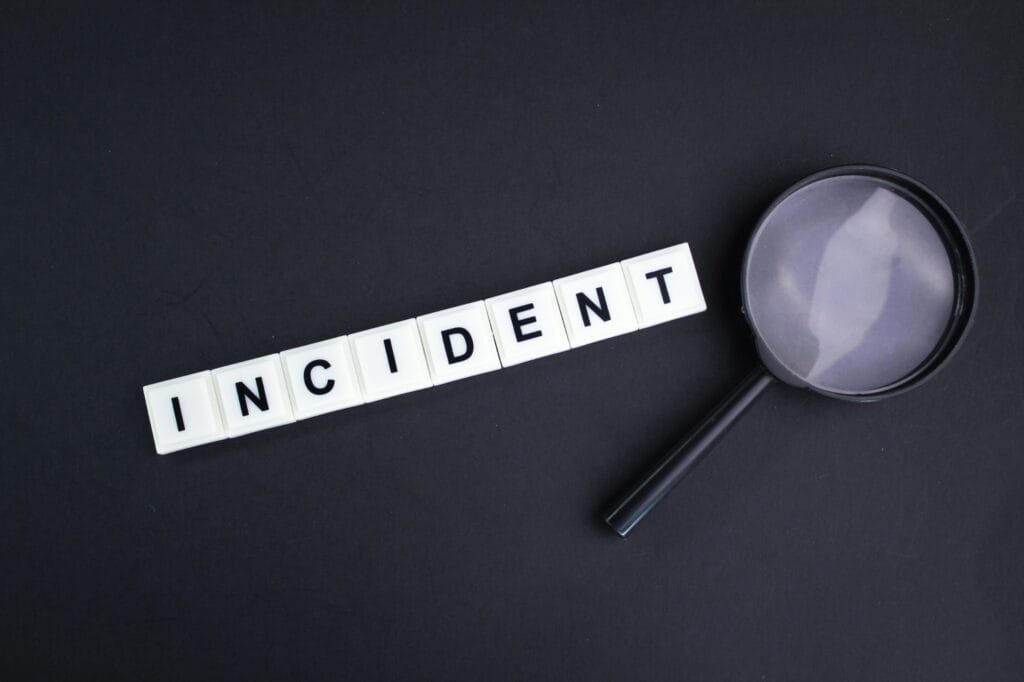6 Steps for Effective Incident Investigation
Need to master the incident investigation process? In this article, we break down the essential steps—securing the scene, collecting data, analysing it, and implementing corrective actions—based on guidance from the Health and Safety Executive (HSE). Learn how to identify root causes and ensure compliance with safety regulations to prevent future incidents.
Key Takeaways
- Effective incident investigations focus on identifying root causes and implementing corrective actions to enhance safety and prevent future incidents, adhering to HSE best practices.
- A structured investigation process includes securing the incident scene, collecting and analysing data, and documenting findings to ensure compliance with health and safety regulations.
- Best practices such as continuous training, regular safety audits, and collaborative investigation teams enhance workplace safety and foster a culture of continuous improvement, as recommended by the HSE.
The Importance of Incident Investigations

Conducting thorough incident investigations is crucial for several reasons. First and foremost, they help identify the root causes of incidents, allowing organisations to implement corrective actions that improve safety. The primary goal is to determine the reasons behind the incident and take preventive actions. This focus on finding facts and taking corrective actions, rather than establishing blame, aligns with the HSE’s approach to promoting a positive safety culture.
Incident investigations also help organisations comply with laws and standards, meet public expectations, and gather relevant information to prevent future occurrences. A thorough investigation provides insights into the failures that led to the incident and helps improve future safety practices.
Investigating workplace accidents enables organisations to identify both direct and indirect causes, allowing them to address these issues effectively.
Identifying Root Causes
Identifying root causes is essential in incident investigations. Concentrating on underlying causes instead of immediate factors helps prevent similar incidents. Examining contributing factors like the work environment, physical abilities of people involved, and organisational systems can reveal all potential causes, allowing organisations to address them effectively. This method helps identify previously identified risks that may have been overlooked.
Failures of both management systems and organisational requirements can be direct or indirect causes of incidents and should be thoroughly considered during the investigation. Examining the physical and mental conditions of individuals involved in incidents ensures a comprehensive investigation. Regular training and effective communication channels among employees also play a crucial role in maintaining a safe work environment.
Compliance with Safety Regulations
Compliance with health and safety regulations is another important aspect of incident investigations. Key points include:
- The HSE and other jurisdictions provide guidance requiring businesses to conduct incident investigations to ensure workplace safety.
- A thorough incident investigation ensures clear documentation and physical evidence, such as CCTV tapes and inspection reports, essential for compliance and insurance purposes.
- Conducting periodic audits helps organisations ensure that safety measures remain effective and compliant with regulations.
Meeting legal and organisational requirements is not just about avoiding penalties; it also demonstrates a commitment to occupational health and safety. Proper documentation and reporting of incidents help organisations maintain transparency and accountability, fostering a culture of continuous improvement in safety practices.
Essential Steps in the Incident Investigation Process

Understanding the essential steps involved in the incident investigation process is crucial for conducting effective investigations. An effective incident investigation consists of multiple steps and requires coordination among stakeholders as well as the integration and analysis of data. The main steps in the investigation process include:
- Securing the incident scene
- Planning the investigation
- Collecting data
- Analysing the data
- Implementing corrective actions
- Documenting and reporting findings.
These steps provide a structured approach to investigations, ensuring that all aspects of the incident are thoroughly examined. By following this incident investigation step-by-step guide aligned with HSE recommendations, organisations can develop strategies to address underlying causes and prevent future incidents.
Step 1: Secure the Incident Scene
Securing the incident scene is the first and most crucial step in the incident investigation process. Key actions include:
- Providing first aid to the injured person
- Making the area safe by using personal protective equipment (PPE) as necessary
- Blocking off the area
- Using barriers or cones to protect sensitive areas and preserve the integrity of the physical evidence
- Taking photographs of the area and specific items before moving them to preserve evidence effectively.
Investigating the location where the incident occurred ensures accurate documentation of relevant information, including weather conditions and safety devices present. By securing the incident scene promptly, investigators can prevent similar events and ensure a thorough investigation.
Step 2: Plan the Investigation
Planning the investigation involves:
- Forming an investigation team that includes members with relevant specialisations and knowledge of organisational requirements
- Outlining the necessary resources
- Creating a detailed plan that clarifies who will be involved and what resources are needed
- Preparing a kit with relevant documents and tools to ensure a smooth investigation process, including pencils, paper, cameras, recording devices, and tape measures.
This thorough preparation ensures that the responsible investigation is conducted without unnecessary delays or obstacles.
Step 3: Collect Data
Collecting data is a critical step in the incident investigation process. Key sources and methods include:
- Technical data sheets
- Inspection reports
- Past incident reports
- Information from the people involved and witnesses
- Promptly interviewing witnesses using open-ended questions to gather detailed and unbiased accounts
- Using checklists to ensure accuracy and cover all critical investigation aspects.
Digital platforms can streamline data collection by gathering incident investigation forms, photographic evidence, and incident logs systematically. By collecting comprehensive and accurate data, investigators can ensure a thorough analysis of the incident.
Step 4: Analyse the Data
The goal of analysing collected data in an incident investigation is to find the root cause. This involves identifying a chain of events leading to the incident rather than focusing solely on immediate causes. Root cause analysis helps uncover underlying issues, which is essential for preventing future incidents.
To fill gaps in understanding the incident, it may be necessary to re-interview witnesses or seek additional data. Considering all possible causes, including human error influenced by the work environment and physical abilities, ensures a comprehensive analysis and accurate identification of the root cause.
Step 5: Implement Corrective Actions
After understanding the incident, the following steps are crucial:
- Implement corrective actions to mitigate future risks
- Track the progress of these actions to ensure their effective implementation
- If the causes are unclear, make recommendations that address the identified deficiencies and previously identified risks.
Recommendations made after an incident should avoid suggesting discipline against individuals involved. A common mistake in investigations is focusing only on direct causes instead of addressing both root and underlying causes.
Conducting frequent safety inspections helps identify potential hazards and facilitates the implementation of prompt corrective actions involving safety devices.
Step 6: Document and Report Findings
A proper accident investigation serves as documentation for legal and insurance requirements. Employers must conduct thorough investigations and report their findings to comply with safety regulations. Thorough documentation and precise reporting of findings, analyses, and corrective actions are essential post-investigation.
Communicating findings and recommendations to workers and management is crucial after an incident investigation. Documentation should include elements like:
- Investigation reports
- Fact sheets
- Alerts
- Presentations.
Reporting findings can involve several formats, such as formal reports, alerts, presentations, and meeting topics.
Emphasising the quality of the single-event incident report is crucial for delivering clear and comprehensive information that has been reported with sufficient detail.
Tools and Techniques for Effective Incident Investigations

Gathering information from various sources, including witnesses and documents, is essential to understanding the incident. The investigation process is assisted by:
- Checklists
- Proformas
- Posters
- Software tools.
Collaborative efforts involving a diverse team enhance objectivity, as recommended by HSE.
Using Checklists and Forms
Checklists and incident investigation forms are crucial in the data collection process. Checklists streamline data collection by providing a structured approach. Forms ensure thorough analysis by allowing systematic documentation of findings and insights.
Implementing checklists and forms results in a more efficient and effective incident investigation process.
Digital Solutions for Incident Management
Digital platforms facilitate:
- Easy documentation and retrieval of incident-related data streamlines the investigation process
- Secure storage and easy access to documents from anywhere through cloud-based platforms
- Real-time collaboration among team members.
A digital incident management system platform assists in tracking multiple corrective actions and plays a crucial role in managing and documenting the investigation process effectively.
Common Challenges and How to Overcome Them

Incident investigations often face the following challenges:
- Communication barriers occur when witnesses hesitate due to fear of retaliation
- Delayed incident reporting can lead to the loss of crucial evidence, including physical evidence, and significantly hinder accurate investigations
- Inadequate documentation can obstruct the investigation process, making it difficult to identify the actual causes.
The complexity of modern work environments makes identifying contributing factors more difficult, requiring thorough investigative techniques. Preconceived notions during investigations may lead to overlooked facts, highlighting the need for an impartial and objective review process.
Dealing with Human Error
Human error can be influenced by various factors related to work, environment, and individual physical abilities, as well as the actions of other workers. Failing to address these errors may result in future incidents from similar causes, potentially leading to injury and serious consequences for the injured person. Errors can happen if not properly managed.
Investigations should focus on remedying the situation rather than establishing blame. The purpose of identifying human errors is to improve systems, not discipline individuals.
Ensuring Objectivity
Involving a team of people in the investigation process gathers varied perspectives and reduces bias. A thorough review of findings and recommendations ensures different viewpoints are considered, enhancing objectivity. Jurisdictions provide guidance encouraging this collaborative investigation team approach.
This collaborative approach ensures thorough investigations and accurate identification of root causes.
Best Practices for Preventing Future Incidents

An effective incident investigation process involves a structured approach to gathering, analysing, and documenting information to prevent future incidents. Safe workplace practices can significantly reduce injuries and associated costs. Implementing best safety practices lowers the risk of workplace incidents.
Analysing incidents helps organisations identify trends and patterns, informing safety management improvements.
Continuous Training and Education
Ongoing training enhances employee knowledge and skills, leading to a more effective safety culture. Regular updates reinforce safety protocols and keep employees engaged. Each incident offers a learning opportunity for continuous safety improvements, with ongoing improvements happening in the process.
Addressing human error aims to improve systems, not punish individuals.
Regular Safety Audits
Regular safety audits are crucial for identifying potential workplace hazards and helping prevent accidents. Conducting safety audits typically involves systematic inspections, interviews, and reviews of safety records.
Implementing findings from safety audits enhances safety protocols and reduces workplace incidents.
Summary
Effective incident investigations are pivotal for maintaining a safe and compliant workplace. By understanding and implementing the six essential steps—securing the incident scene, planning the investigation, collecting data, analysing the data, implementing corrective actions, and documenting and reporting findings—organisations can ensure thorough investigations that not only uncover the root causes of incidents but also help prevent future occurrences.
The use of tools and techniques such as checklists and digital solutions, along with overcoming common challenges like human error and ensuring objectivity, is integral to the investigation process. By adopting best practices such as continuous training and regular safety audits, organisations can foster a culture of safety and continuous improvement. Let’s take the knowledge shared in this guide, grounded in Health and Safety Executive principles, to transform our workplaces into safer environments for everyone.








